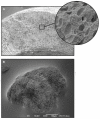Disease-Modifying Adjunctive Therapy (DMAT) in Osteoarthritis-The Biological Effects of a Multi-Mineral Complex, LithoLexal® Joint-A Review
- PMID: 34940003
- PMCID: PMC8700461
- DOI: 10.3390/clinpract11040104
Disease-Modifying Adjunctive Therapy (DMAT) in Osteoarthritis-The Biological Effects of a Multi-Mineral Complex, LithoLexal® Joint-A Review
Abstract
Modern advances in molecular medicine have led to the reframing of osteoarthritis as a metabolically active, inflammatory disorder with local and systemic contributing factors. According to the 'inflammatory theory' of osteoarthritis, immune response to an initial damage is the key trigger that leads to progressive joint destruction. Several intertwined pathways are known to induce and govern articular inflammation, cartilage matrix degradation, and subchondral bone changes. Effective treatments capable of halting or delaying the progression of osteoarthritis remain elusive. As a result, supplements such as glucosamine and chondroitin sulphate are commonly used despite the lack of scientific consensus. A novel option for adjunctive therapy of osteoarthritis is LithoLexal® Joint, a marine-derived, mineral-rich extract, that exhibited significant efficacy in clinical trials. LithoLexal® has a lattice microstructure containing a combination of bioactive rare minerals. Mechanistic research suggests that this novel treatment possesses various potential disease-modifying properties, such as suppression of nuclear factor kappa-B, interleukin 1β, tumor necrosis factor α, and cyclooxygenase-2. Accordingly, LithoLexal® Joint can be considered a disease-modifying adjunctive therapy (DMAT). LithoLexal® Joint monotherapy in patients with knee osteoarthritis has significantly improved symptoms and walking ability with higher efficacy than glucosamine. Preliminary evidence also suggests that LithoLexal® Joint may allow clinicians to reduce the dose of nonsteroidal anti-inflammatory drugs in osteoarthritic patients by up to 50%. In conclusion, the multi-mineral complex, LithoLexal® Joint, appears to be a promising candidate for DMAT of osteoarthritis, which may narrow the existing gap in clinical practice.
Keywords: LithoLexal; anti-inflammatory agents; cytokine inhibitors; disease-modifying adjunctive therapy; lithothamnion; osteoarthritis.
Conflict of interest statement
The authors declare that they have no conflict of interest.
Figures


References
Publication types
LinkOut - more resources
Full Text Sources
Research Materials
Miscellaneous

